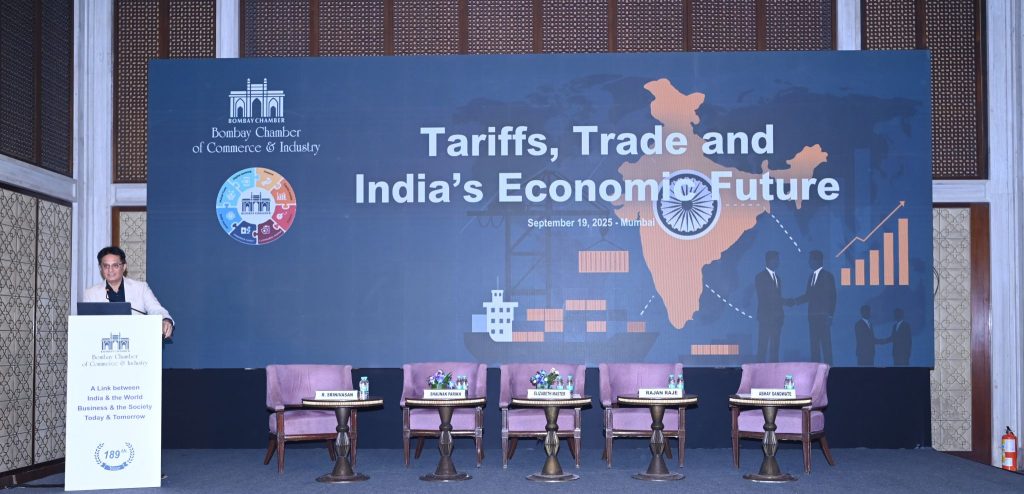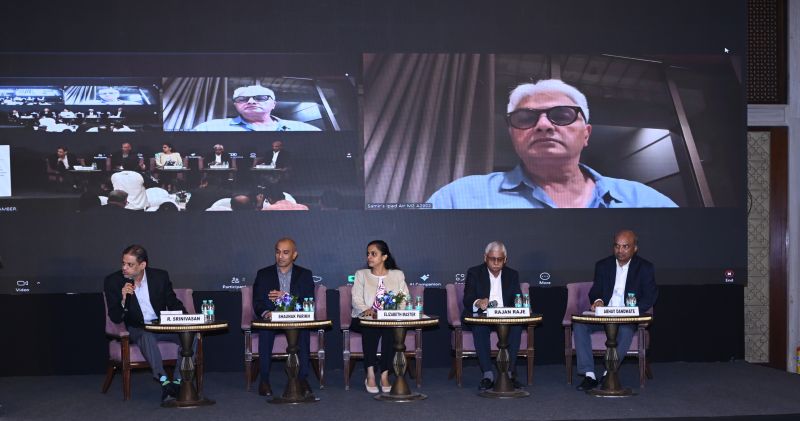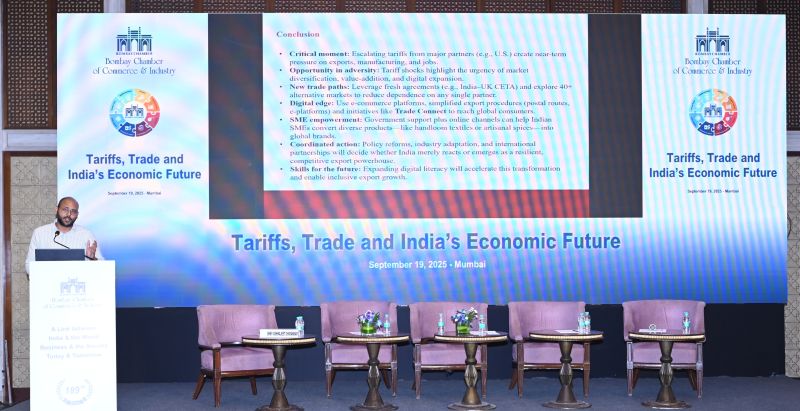Blog
Mumbai: The Bombay Chamber of Commerce and Industry convened a high-level panel discussion titled ‘Tariffs, Trade and India’s Economic Future’, bringing together sectoral leaders to assess the impact of recent US tariff measures on Indian exports. The consensus was clear: while diversification and long-term reform are essential, immediate government intervention is critical to prevent lasting damage to employment and industry.

In his welcome address, Sandeep Khosla, Director General, Bombay Chamber, underscored the timeliness of the panel amid ongoing volatility surrounding US tariffs on Indian exports. He noted the pace at which the situation continues to evolve, marked by frequent developments and high-level diplomatic exchanges. This climate of uncertainty, he said, has made forward planning increasingly difficult for businesses. Against this backdrop, the panel aimed to examine the wide-ranging impact on Indian industries, particularly MSMEs, and highlight the importance of vigilance and adaptability in navigating the challenges ahead.

Moderating the panel, R. Srinivasan, Co-Chairperson of the MSME Forum at the Bombay Chamber and Director at AIRA Consulting, opened the discussion with a central question: Why is the United States such a crucial market for India, and how will the tariffs affect various sectors?
Elizabeth Master, Associate Director at Crisil Intelligence, responded by framing the US as a cornerstone of India’s export economy. “The US remains our most significant trading partner across various industries, especially in IT services. The new tariffs will have a measurable impact on India’s overall economic growth, even after accounting for recent Goods and Services Tax (GST) reductions,” she said. The effects, she added, ripple beyond the obvious sectors, noting that even IT services – initially considered resilient – have experienced project delays and revenue slowdowns due to broader economic uncertainty.
The gems and jewellery sector, according to Shaunak Parikh, Director at Mahendra Brothers Group and Vice Chairman of the Gem & Jewellery Export Promotion Council (GJEPC), faces acute challenges. “One-third of our exports go directly to the US,” Parikh said. “Front-loading shipments offered temporary relief, but the long-term threat is real. Competing countries are already positioning themselves to take our market share.” He emphasised the human cost, pointing out that the industry employs millions with highly specialised skills. “These are not easily transferable jobs. Layoffs here mean irreversible damage to livelihoods,” he said.
Samir Bhuta, Partner at Shreeji Exim Works LLP and member of the Apparel Export Promotion Council (AEPC), described the situation in the textiles and apparel sector as ‘COVID-like’. “Factories are running at half capacity. Workers are being laid off. The ecosystem – from suppliers to transporters – is collapsing,” he said. On the likelihood of US buyers lobbying on India’s behalf, Bhuta expressed scepticism saying, “They have alternatives. They are already shifting orders and demanding price cuts. Our margins are being squeezed to the bone.”
In contrast, Rajan Raje, Chairperson – MSME Forum, Bombay Chamber & CEO of Nichem Solutions, offered a more tempered view from the chemical industry. “Our exposure to the US is relatively limited,” he said. “Specialty chemicals may adapt better, provided there is support from both buyers and the government.” Raje also highlighted the burden of non-tariff barriers in the European Union, such as the REACH certification, which disproportionately affects MSMEs. “These are costly and time-consuming. We need to explore new markets in Africa and Latin America, possibly using gateway countries like Mexico and Egypt,” said Raje.
Agriculture presented a mixed picture. Abhay Dandwate, Chief Risk Officer and Head of Strategy at the National Bulk Handling Corporation, noted that while marine exports like shrimp are vulnerable, most Indian farmers – engaged in cereals, pulses and edible oils – are less exposed. “Export volumes had actually increased prior to the tariff announcement, but that growth is likely to stall,” he said. Dandwate cautioned against liberalising imports of genetically modified (GM) crops and dairy products from the US, citing political sensitivities and the potential impact on domestic prices.
Steering the conversation towards policy solutions, Srinivasan invited panellists to share their expectations from the government. He urged them to consider both immediate and long-term measures, including liquidity support, easing customs procedures and regulatory compliance, and structural reforms to improve competitiveness.
Bhuta reinforced the need for a pragmatic outlook. “Even with robust government efforts, ratifying and implementing trade agreements is a lengthy process, and that delay does little to support Indian businesses in the short term,” he said, adding that export volumes from alternative markets fall far short of those achievable in the US.
Parikh outlined the industry’s outreach to government authorities, advocating for measures reminiscent of the COVID-19 response. “We need interest equalisation schemes extended, packing credit deferred, and overdraft facilities made available,” he said. He also proposed allowing Special Economic Zone (SEZ) units to sell excess inventory locally under duty, and called for state-level support such as EMI restructuring and enhanced medical insurance for workers.
Stressing on the importance of consistent policy, Bhuta said, “We cannot operate under schemes that change every few months. We need long-term clarity.” He also called for baseline subsidies across textile-producing states and greater support for transitioning to manmade fibres and sustainable practices. “Global markets, especially Europe, will soon demand higher sustainability standards. We must be ready,” he pointed.
Rajan Raje questioned India’s reluctance to pursue a free trade agreement with the US, attributing the delay to political and emotional considerations. “We need a practical, forward-looking approach. Opening up agriculture to competition could prove beneficial in the long run, as demonstrated during earlier phases of liberalisation,” he said.
Dandwate returned to the theme of financial support, calling for emergency credit arrangements similar to those provided during the pandemic. “Policy consistency is essential – not just for farmers, but for traders and allied sectors,” he said.
Master summarised the industry’s predicament saying the current tariff situation is unviable. “Even a reduction to 20 per cent would offer some relief. Diversification is necessary, but we must first address the immediate pain points. With timely action, this crisis could become a catalyst for structural reform,” she said
The panel discussion was followed by an insightful presentation by Shri Vishwajeet G. Chimankar, Deputy Director General of Foreign Trade (DGFT), Ministry of Commerce and Industry, Government of India.

India’s trade strategy for 2025, as outlined by the DGFT, centres on responding to global tariff shifts and expanding export opportunities. “Following steep US tariffs on key Indian goods, the government resumed trade talks with major partners and signed a landmark agreement with the UK. The India–UK CETA eliminates duties on 99 per cent of Indian exports and facilitates professional mobility through simplified visa processes and dedicated quotas,” said Chimankar.
To reduce reliance on the US market, India has launched a Market Diversification Mission targeting 40 countries with high demand for textiles and apparel. Meanwhile, the DGFT’s Trade Connect platform, linked with ONDC and GeM, offers support to MSMEs and artisans in accessing global e-commerce platforms. Exporters are increasingly using platforms like Amazon and Alibaba, alongside digital marketing and virtual trade fairs, to promote their offerings. “These combined efforts aim to strengthen India’s trade balance, attract foreign investment, and lower export costs through regulatory cooperation and streamlined customs procedures,” Chimankar added.
Sandeep Khosla closed the session with a vote of thanks, reflecting on the depth and relevance of the discussion. He noted that the panel had shed light on the multifaceted challenges arising from recent tariff changes, while also underscoring the resilience of Indian industry. Despite concerns over immediate disruptions, speakers agreed that a swift reconfiguration of production capacity was unlikely. There was cautious optimism, he said, around the prospect of remedial measures by November or December, suggesting that the economic fallout may be less severe than initially anticipated. Khosla concluded by thanking all participants for their thoughtful contributions and reaffirmed the Chamber’s commitment to supporting industry through the evolving trade landscape.
(Write to us at editorial@bombaychamber.com)








